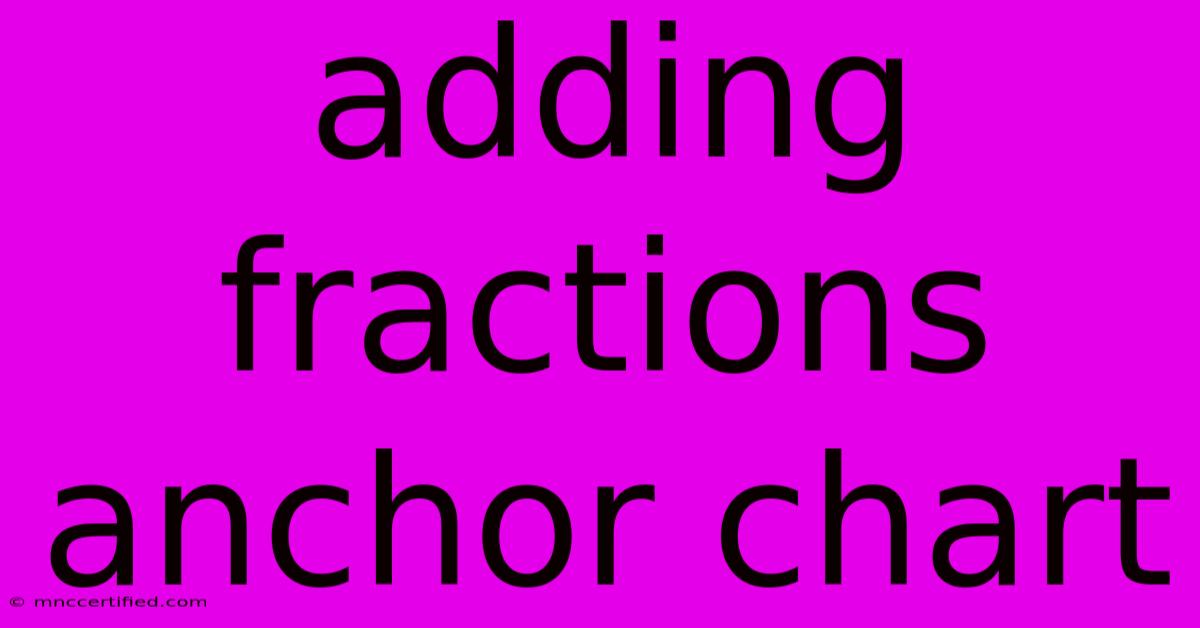Adding Fractions Anchor Chart

Table of Contents
Adding Fractions Anchor Chart: A Comprehensive Guide for Educators and Students
Adding fractions can be a tricky concept for many students. A well-designed anchor chart can be an invaluable tool to clarify the process, provide visual aids, and serve as a readily available reference. This article will guide you through creating an effective adding fractions anchor chart, covering various strategies and incorporating best practices for visual learning.
Understanding the Basics: What Makes a Great Anchor Chart?
Before diving into the specifics of adding fractions, let's establish what constitutes a successful anchor chart. A good anchor chart should be:
- Visually Appealing: Use color, clear fonts, and relevant imagery to capture attention and enhance understanding.
- Concise and Organized: Avoid clutter. Use bullet points, headings, and clear visual separations to organize information logically.
- Actionable: The chart should guide students through the process, not just present definitions. Include examples and steps.
- Accessible: The information should be easily understood and referenced by students of varying learning styles.
Key Concepts to Include in Your Adding Fractions Anchor Chart
Your anchor chart should cover these fundamental concepts:
1. Identifying Key Terminology:
- Numerator: The top number in a fraction (represents the parts you have). Use a visual representation, like a colored-in portion of a circle or rectangle.
- Denominator: The bottom number in a fraction (represents the total number of parts). Again, use a visual, like the total number of sections in a circle or rectangle.
- Like Denominators: Fractions with the same denominator (e.g., 1/4 and 3/4). Emphasize that these are easy to add.
- Unlike Denominators: Fractions with different denominators (e.g., 1/2 and 1/3). Highlight the need for finding a common denominator.
- Common Denominator: A shared denominator for two or more fractions. Explain its importance in adding fractions with unlike denominators.
2. Adding Fractions with Like Denominators:
- Step-by-Step Guide: Clearly illustrate the process:
- Add the numerators.
- Keep the denominator the same.
- Simplify the fraction if necessary.
- Visual Example: Use a picture to show adding like fractions, such as combining parts of a circle or rectangle. For example, 1/4 + 2/4 = 3/4.
3. Adding Fractions with Unlike Denominators:
- Finding the Least Common Denominator (LCD): Explain different methods, such as listing multiples or using prime factorization. Provide examples of finding the LCD for different pairs of denominators.
- Converting Fractions: Show how to convert fractions to equivalent fractions with the LCD. Use visual aids to demonstrate this equivalence (e.g., showing that 1/2 is the same as 2/4).
- Adding the Fractions: Once fractions have a common denominator, reiterate the process of adding the numerators and keeping the denominator the same.
- Simplifying the Answer: Explain how to simplify the resulting fraction to its lowest terms. Provide examples of simplifying fractions.
4. Mixed Numbers:
- Converting Mixed Numbers to Improper Fractions: Show the process of converting a mixed number (a whole number and a fraction) into an improper fraction (numerator is greater than or equal to the denominator).
- Adding Mixed Numbers: Explain how to add mixed numbers, either by converting to improper fractions first or by adding the whole numbers and fractions separately.
Design and Layout Tips for Your Anchor Chart
- Use Color-Coding: Use different colors for numerators, denominators, and steps in the process.
- Include Visual Models: Use diagrams, pictures, and manipulatives (if possible) to represent the fractions.
- Use Clear and Concise Language: Avoid jargon and use simple, straightforward language.
- Keep it Brief: Focus on the most essential information. Avoid overwhelming students with too much detail.
- Laminate for Durability: A laminated chart will last longer and can be used repeatedly.
Beyond the Anchor Chart: Supplementing Learning
While an anchor chart is a great visual aid, supplement it with other activities:
- Practice Problems: Provide ample opportunities for students to practice adding fractions.
- Real-World Applications: Relate adding fractions to real-life situations, like measuring ingredients in a recipe.
- Games and Activities: Use interactive games and activities to make learning more engaging.
By following these guidelines, you can create a highly effective adding fractions anchor chart that will significantly aid students in mastering this crucial mathematical concept. Remember to regularly review and adjust your anchor chart based on student needs and understanding. The goal is to make adding fractions accessible and less daunting for every learner.

Thank you for visiting our website wich cover about Adding Fractions Anchor Chart. We hope the information provided has been useful to you. Feel free to contact us if you have any questions or need further assistance. See you next time and dont miss to bookmark.
Featured Posts
-
Yellow Fog Warning Louth And Meath
Nov 28, 2024
-
Mishal Husain Leaving Bbc After 25 Years
Nov 28, 2024
-
Ankle Injury Tsimikas Sidelined For Liverpool
Nov 28, 2024
-
Jedediah Starr Trading Company
Nov 28, 2024
-
Stake Us Bonus Drop Code 2023
Nov 28, 2024